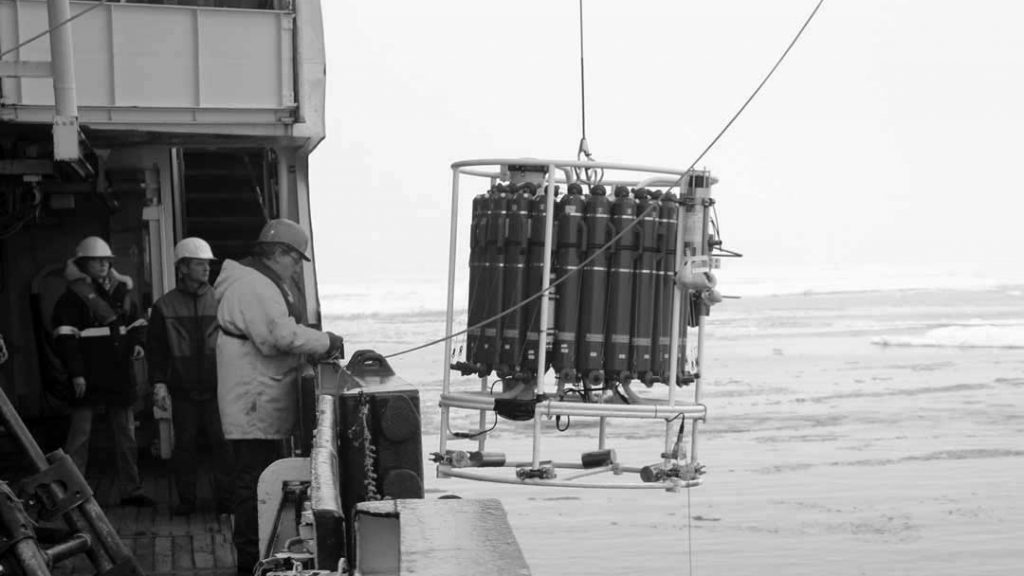
The plume abides. Dao-yo master Janna (left) looks on as Rainer (center) and Frank (right) prepare to lower the CTD into the ocean depths. (photo by Chris German, Woods Hole Oceanographic Institution)
We had a really interesting time with the CTD last night. New science has come to light, so to speak.
First some background. There are two parts to a “tow-yo” cast with a CTD: the tow part, in which we pull the CTD through the water in a controlled manner, and the yo-yo part, in which we raise and lower the CTD through the water as we move across the surface. An important part of the success we have had with our tow-yos recently is that Maren, Janna, and I realized that the lowering part of the yo-yo action (a “yo”) needed to be better controlled.
However, towing something through the Arctic sea ice is not always possible, simply because going where you want at a speed you want is not always possible. So we’ve had to content ourselves with drifting with the ice while we yo-yo the CTD through the water. But our thinking was that, if we were going to go so far as to now call them “drift-yos,” then we would have to believe that we actually knew where and how fast the ice was going to carry us. Which, from moment-to-moment, we do not.
As a result, we’ve settled into a calm resignation based on the realization that, where so little is known and there is no prior data, anything we can glean from the water will advance human knowledge of this place. So, in honor of the Chinese religious philosophy of Daoism upon which our newfound calm is loosely based, we’ve started calling them “Dao-yos.” Or, as Maren said to me, “We go with the (ice) floe.”
I wish I had such control of language—even my own native tongue, let alone a second language, as English is for Maren.
Anyway, never was our Dao-yo philosophy better on display than late last night when we started a cast that was intended to take us right over what could be (in my wildest dreams and flights of fancy, backed up by plausible data and rationale arguments) a frozen lava lake.
Within thirty minutes of starting, it was clear that our next seven hours would, as has been happening lately, not be going to plan. Instead, we would be taking our instrument into the depths of a new and unplanned part of the ocean.
So while our Chief Scientist, Antje, called down from the bridge, fretting over whether we needed to give up and/or relocate, we assured her that all would be well and continued to think our deep, calm thoughts.
We lowered the CTD, which sniffs for signs of vent-plumes in the water and sends data up to us in real time, until it reached a point close above the seafloor just north of our target and about 1 kilometer (0.6 mile) east of where we had wanted it to be, heading south. Although there was immediate no sign of the plume, we decided not to panic and decided to see the glass as an opportunity: When we intercepted the plume later in the cast, so our thinking went, we would know exactly where its northern limit was and, as we continued south, we would pass out of its furthest extent, as well. All would be fine.
After two casts, we decided to back up our positive thoughts and inner calm by breaking out my final remaining bag of “Lucky Gummi Bears.” That did the trick.
On the next lowering we intercepted a beautiful, fresh, set of hydrothermal plume signals that then got progressively weaker and less fresh as we continued along our path until, three hours later, they ran out. At 1:00 a.m., it was time to haul the package back to the ship, wake the biochemistry team, and turn in.
Throughout the Dao-yo, we had been collecting water samples for the biogeochemists wherever we saw interesting signals on our real-time sensors, and now they came, blinking the sleep from their eyes, up onto deck to collect their cold, salt water treasure for people like Jill and Kevin, who are working on the ship and for those working in Germany.
Some set to work immediately, measuring what they could. Others made sure their samples were properly collected and safely preserved, then slunk off below decks and back to their bunks.
But even before those data become available, we already have indications of: 1. Which way the plume is blowing; 2. How the geochemistry of the plume is evolving, and, crucially; 3. Some key characteristics of the vent source on the seafloor.
That last point is crucial, because it turns out I am now quite convinced of something I first suggested as early as last Sunday night, that the plume signals we have been following might not come from a black smoker. In fact, that might also be true of ALL the data ever collected from this site for the past 15 years, which is a fundamental part of what this cruise proposal was based on.
Being right can make you smug, but being wrong can make you smarter, so long as you can learn from your mistakes and don’t just keep repeating them. In that way, being wrong is often the more interesting option.
What we now think is happening here at Misery Mountain (as one scientist referred to it at lunch) is that somewhere on the seafloor nearby is a vent emitting hot, clear fluids, rather than thick, “smoky,” clouds of black, mineral-rich particulates. As the clear fluids rise and mix with the overlying ocean, only then do we think that particulate minerals grow and disperse with the plume as it drifts farther from the source. Pretty cool, huh?
By logical deduction, coupled with drawing on everything I have ever read about other vents elsewhere on our planet, I have put forward the idea that the seafloor vents we are looking for are not the 350°C (660°F) black smokers we were envisioning as recently as just a few days ago, but rather might be clear fluids at a temperature closer to 300°C (570°F).
So far, nobody I have run this by thinks I am wildly off target. Except for Jill. At dinner she told me she thought they would be 310°C (590°F). Ah, the impetuosity of youth—I had some of that once. Since Jill has one more PhD than me on vent-fluid geochemistry, I am inclined to defer to her. Though how we are going to prove that she is right using some downward-looking photographs from the OFOS camera system, if we can ever steer ourselves right over the site, I am not sure.
But I digress. The bottom line: That last Dao-yo (and the Lucky Gummis) really pulled the plume together.

